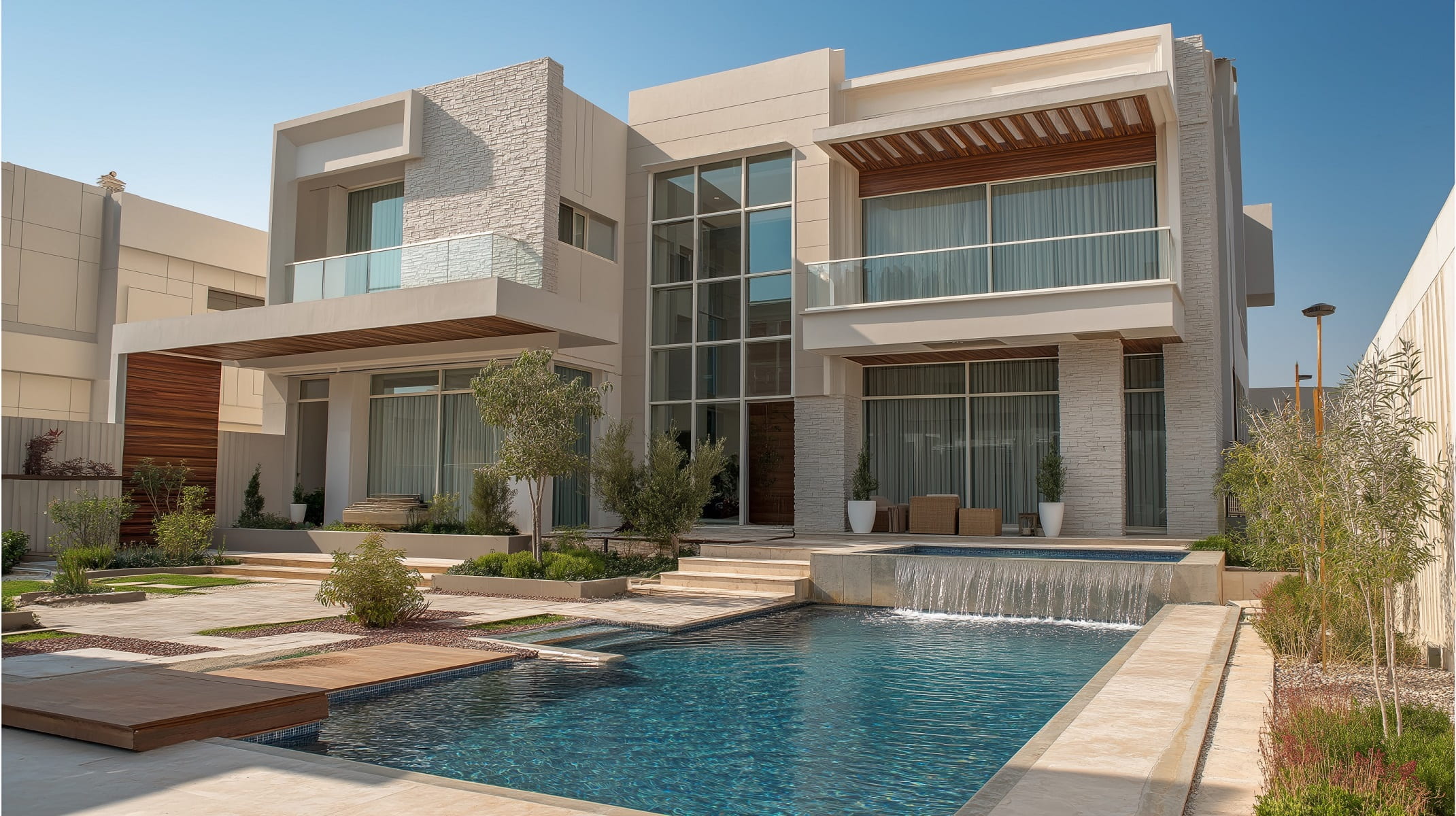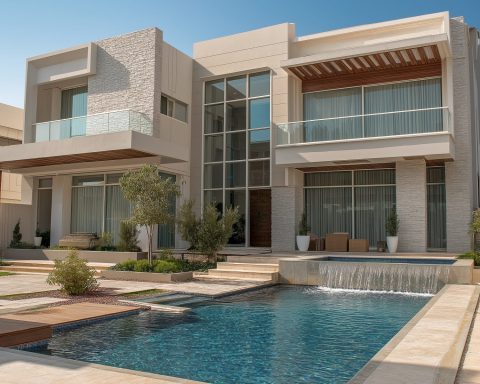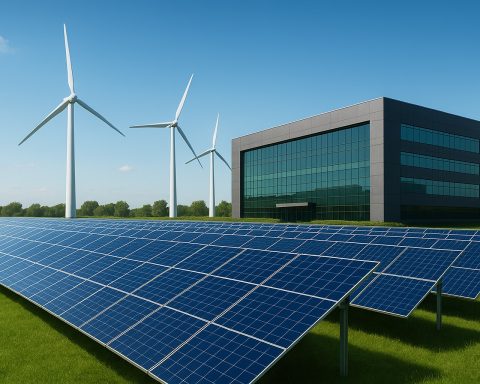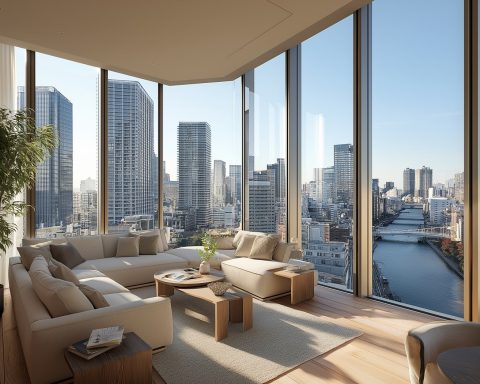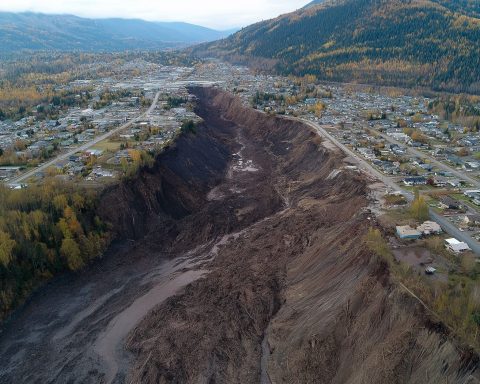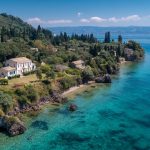Jeddah’s real estate market is entering 2025 on a strong footing, buoyed by robust demand and government-led initiatives under Saudi Vision 2030. Residential sales activity in the city surged in the past year – Jeddah recorded a 43.5% year-on-year jump in home sales transactions, far outpacing Riyadh’s growth jll-mena.com. Prices show a mixed trend: villa values have been rising even as apartment prices saw slight corrections jll-mena.com. On the commercial side, Jeddah’s office and retail sectors are expanding steadily with new projects, although growth is more measured compared to the booming capital, Riyadh argaam.com argaam.com. Major infrastructure developments – from the Jeddah Central waterfront project to the resumption of the Jeddah Tower construction – are transforming the skyline and creating new investment opportunities. Government policies aimed at increasing homeownership and attracting foreign investment (including opening up parts of the market to international investors) are further catalyzing growth jll-mena.com agbi.com. This report provides a detailed analysis of Jeddah’s residential and commercial real estate trends in 2025, examines the impact of Vision 2030 initiatives and key projects, compares Jeddah with other Saudi hubs like Riyadh and Dammam, and offers a market forecast through 2030 with an outlook on opportunities and risks for investors and developers.
Residential Real Estate Trends in Jeddah
Sales and Price Trends: Jeddah’s housing market has been dynamic, with demand accelerating over the past year. Home sales transactions in Jeddah climbed by 43.5% year-on-year as of early 2025 jll-mena.com, reflecting a surge of buyer interest. This uptick coincides with nationwide efforts to boost homeownership – programs like Sakani and the Real Estate Development Fund are making it easier for first-time buyers to purchase homes, which has stimulated demand significantly jll-mena.com. Price-wise, Jeddah saw mixed movements: villa sale prices have continued to increase, whereas apartment prices have softened slightly in recent quarters jll-mena.com. For context, during the first half of 2024 Jeddah’s residential sale prices were up about 5% year-on-year, with rents up around 4% argaam.com argaam.com. This is a more modest growth compared to Riyadh (where housing prices jumped ~10% in the same period) argaam.com. The relative cooling in apartment prices suggests an adjustment after several years of rapid growth, and possibly more supply coming online in that segment.
Demand and Housing Supply: Demand in Jeddah is gravitating toward modern, master-planned communities. Both locals and expats are showing a preference for “community living” with integrated amenities, rather than standalone properties jll-mena.com. In particular, north Jeddah has emerged as a hotspot – this area has seen the most significant price appreciation, fueled by new higher-end developments and infrastructure argaamplus.s3.amazonaws.com argaamplus.s3.amazonaws.com. Upper-middle to high-end residential units are in growing demand, aligning with Jeddah’s status as a commercial hub and gateway for pilgrims and tourists argaamplus.s3.amazonaws.com. Popular neighborhoods include waterfront and northern districts (such as Obhur and Al-Shati/Waterfront areas) which offer new villas, gated compounds, and seaside apartments. Recent data indicates that nearly all of Jeddah’s price growth in 2023 was concentrated in the north of the city argaamplus.s3.amazonaws.com, where several large-scale housing projects are underway.
On the supply side, development activity is robust. In the first half of 2024 alone, 11,300 new residential units were delivered in Jeddah, bringing the city’s total housing stock to roughly 891,000 units argaam.com argaam.com. Another 16,000 units were slated for completion in the latter half of 2024 argaam.com. Major developers – including the Public Investment Fund’s ROSHN – are active in Jeddah. ROSHN’s Al-Arous project in north Jeddah, for example, plans to add around 18,000 new homes in a master-planned community, expanding supply of modern middle-class housing. Such developments support the government’s Vision 2030 target of increasing Saudi homeownership (with a goal of 70% homeownership by 2030, up from about 62% in 2020 pwc.com pwc.com). In addition, improved access to mortgages (helped by the Saudi Real Estate Refinance Company’s liquidity and lower down payment requirements) has enabled more young families to buy homes pwc.com pwc.com, sustaining demand for new residential projects.
Rents and Yields: Jeddah’s rental market has been tightening. With population growth and an influx of expatriate professionals in certain sectors, apartment rents saw a notable rise recently – average apartment rents jumped by 18% year-on-year in 2023, according to one market review argaamplus.s3.amazonaws.com argaamplus.s3.amazonaws.com. Villa rents have also climbed (by high single digits annually), though rents remain generally lower than in Riyadh. As of late 2023, typical apartment rents in Jeddah ranged widely from about SAR 14,400 up to SAR 75,000 per year, depending on location and quality, while villa rents ranged from roughly SAR 60,000 to SAR 175,000 per year argaamplus.s3.amazonaws.com argaamplus.s3.amazonaws.com. These rent increases reflect both high demand and limited availability of quality units in prime areas. However, with significant new supply coming in 2024–2025, rental growth may moderate. Yields for landlords have been attractive in recent years given rising rents, but investors are watching for potential oversupply risk toward 2030 as tens of thousands of units are added. Overall, Jeddah’s residential sector remains on a “positive trajectory toward further expansion,” supported by strong underlying demand and government housing initiatives argaam.com.
Commercial Real Estate Trends (Office, Retail, Industrial)
Office Market: Jeddah is the Kingdom’s second-largest office market after Riyadh, and it continues to grow steadily. Total office stock in Jeddah is approximately 1.2 – 2.1 million square meters (the range reflecting different classes of space) argaamplus.s3.amazonaws.com argaam.com, which is about one-quarter the size of Riyadh’s office inventory. In the first half of 2024, no major new offices opened in Jeddah, keeping supply flat at around 1.21 million m² of quality space argaam.com. However, new projects are finally in the pipeline – roughly 48,000 m² of office space is expected to be delivered by end of 2024 in Jeddah argaam.com. Demand for offices has been healthy, driven by business growth and Jeddah’s role as a trading and logistics hub. Grade A office rents in Jeddah rose about 11% year-on-year by mid-2024 to roughly SAR 1,335 per m² per annum argaam.com, indicating landlords have gained leverage as quality space remains limited. (For comparison, top office rents in Riyadh’s prime areas jumped nearly 20% over the same period to about SAR 2,090 per m² argaam.com, reflecting even hotter demand in the capital). Most of Jeddah’s prime office tenants are government entities and established corporates argaamplus.s3.amazonaws.com, and new high-grade buildings face competitive pressure to secure these large occupiers argaamplus.s3.amazonaws.com. Going forward, the office sector in Jeddah is expected to expand alongside economic growth, but at a measured pace – the city lacks the huge corporate relocation boom seen in Riyadh. Vacancy rates are relatively stable, and if new supply remains limited, rents should hold firm. One trend to watch is the modernization of office stock: new mixed-use developments (like parts of the Jeddah Central project) will introduce state-of-the-art office spaces, potentially drawing tenants from older buildings and putting pressure on aging stock.
Retail Real Estate: Retail is a bright spot in Jeddah’s commercial landscape, supported by a young population and growing tourism. In 2024, Jeddah added 106,000 m² of new retail space (e.g. a major mall opening), bringing total retail supply to about 2.16 million m² in the city argaam.com argaam.com. This expansion reflects confidence in consumer demand. Thanks to Vision 2030’s push to boost entertainment and leisure, malls in Jeddah have increasingly incorporated cinemas, restaurants, and family attractions to draw foot traffic. Retail rents in prime “super-regional” malls have been edging up (about +4% YoY in H1 2024 for top-tier malls) argaam.com, while secondary malls with older formats have seen rents decline (~4% down YoY) as shoppers gravitate toward newer experiences argaam.com. Overall, retail market sentiment is optimistic for 2025-2026, with S&P Global noting that population growth, expanding tourism, and the entry of international brands will propel further retail demand across Saudi cities arabnews.com arabnews.com. Riyadh and Jeddah, in particular, are witnessing a wave of new retail and mixed-use developments that blend shopping with entertainment and even residential/hospitality components arabnews.com. In Jeddah, open-air and waterfront retail concepts are gaining popularity (for example, the Corniche areas and destinations like Jeddah Yacht Club district), reflecting a trend toward lifestyle-centric shopping districts arabnews.com. That said, the retail sector is not without risks: e-commerce growth and changing consumer preferences mean mall operators must continue innovating to attract visitors. S&P has cautioned that oversupply and competition could put pressure on rental yields, especially if landlords undertake heavy capital expenditures to revamp properties arabnews.com. For now, though, Jeddah’s retail real estate is buoyed by strong consumer spending – helped by high per-capita income and a culture that treats malls as social destinations arabnews.com arabnews.com. With Saudi Arabia targeting 100+ million tourists by 2030, including mega-events like Expo 2030 and a 2034 FIFA World Cup, Jeddah’s role as a gateway city positions its retail sector for sustained growth arabnews.com.
Industrial & Logistics Properties: The industrial real estate segment in Jeddah is experiencing significant growth under the radar, aligned with Saudi Arabia’s logistics ambitions. As the Kingdom’s main Red Sea port city, Jeddah is central to plans to become a global logistics hub, and this is driving demand for modern warehouses and distribution centers argaamplus.s3.amazonaws.com argaamplus.s3.amazonaws.com. The e-commerce boom post-2020 has further boosted requirements for large, high-quality logistics facilities argaamplus.s3.amazonaws.com. In 2023, Saudi Arabia launched four new Special Economic Zones (SEZs) to attract industrial and high-tech investment – notably, one of these is at King Abdullah Economic City (KAEC) near Jeddah argaamplus.s3.amazonaws.com. KAEC’s SEZ focuses on advanced manufacturing and logistics and is expected to spur development of warehouses and factories in the Jeddah vicinity. Prime warehouse rents in Jeddah currently range roughly from SAR 90 to 300 per m² per year, depending on location and specification argaamplus.s3.amazonaws.com argaamplus.s3.amazonaws.com. These rents have been climbing as vacancy for quality space is low – indeed, industrial rents saw mid-to-high single digit percentage increases in 2022–2023. While Jeddah’s warehouse rents are a bit lower than Riyadh’s (which can go up to SAR 400/m²) argaamplus.s3.amazonaws.com argaamplus.s3.amazonaws.com, the gap may close as more 3PL (third-party logistics) providers and manufacturers set up operations by the port. The ongoing Saudi Landbridge Project – a massive rail line linking Jeddah Port to Riyadh and Dammam – is another game-changer, expected to be completed around the end of the decade. By enabling faster cargo movement across the country, it will likely increase demand for logistics parks around Jeddah’s port and industrial zones. Overall, the industrial real estate outlook is bullish: Vision 2030’s diversification drive is catalyzing growth in warehousing, and Jeddah stands to gain with its strategic location. The main challenge will be delivering sufficient new industrial supply; otherwise, rents could continue rising and possibly squeeze smaller businesses. However, with new land and infrastructure investments (including the SEZ incentives), investors see solid opportunities in logistics real estate. As one report noted, Saudi industrial demand is underpinned by a “significant growth” trend that is set to continue as the non-oil economy expands argaamplus.s3.amazonaws.com argaamplus.s3.amazonaws.com.
Key Government Policies and Vision 2030 Impact
Government policy – guided by the Vision 2030 strategic framework – plays a pivotal role in Jeddah’s real estate market. One of the flagship goals of Vision 2030 is to raise Saudi homeownership to 70% by 2030, from around 50% or lower in the mid-2010s pwc.com pwc.com. To achieve this, the Ministry of Housing (now part of MoMRAH) has implemented sweeping reforms that have transformed the housing sector. Key initiatives include the Sakani program, which streamlines and subsidizes home loans for Saudi families, and the Real Estate Development Fund which provides low-cost financing. These programs have cut wait times for housing support from years to near-immediate approval vision2030.gov.sa, unleashing a wave of end-user demand. As noted earlier, government-backed mortgages and reduced down payment requirements (cut from 30% to 5% by the central bank) have empowered a new generation of buyers pwc.com. The result is evident in Jeddah, where many previously rental-bound households are now entering the ownership market – stimulating residential construction across different price tiers.
Vision 2030’s influence extends beyond housing into commercial real estate via economic diversification and regulatory liberalization. The government recognizes real estate as a key sector to grow non-oil GDP (with a target to raise real estate’s GDP contribution from ~7% to 10% by 2030) pwc.com. To encourage development, authorities have invested heavily in infrastructure – new transport links, utilities, and public realm improvements – especially in cities like Jeddah which serve tourism and trade. A noteworthy policy is the White Land Tax, a levy on undeveloped urban land introduced to discourage land banking and increase the supply of plots for development pwc.com. Jeddah was one of the first cities where this 2.5% annual tax was applied on vacant residential land, which has prodded some landowners to either build or sell, gradually improving land availability for projects. Additionally, streamlined permitting and public-private partnership models have made it easier for developers to undertake large projects aligned with Vision 2030 objectives (for example, the Jeddah Central redevelopment is spearheaded by the Public Investment Fund in partnership with private contractors).
Tourism promotion under Vision 2030 is another policy area impacting Jeddah real estate. The Kingdom aims to attract 100 million visits annually by 2030 (from religious tourism, leisure, and business events). Jeddah, as the traditional gateway to Mecca and Medina and a Red Sea coastal city, benefits from this push. The government’s ease of tourist visas and investment in tourism infrastructure (airports, cruise terminals, etc.) have stimulated construction of new hotels, serviced apartments, and retail-entertainment complexes in Jeddah. The spillover effect on retail and hospitality real estate has been significant – for instance, hotel occupancy and room rates in Saudi Arabia have been rising and developers in Jeddah are responding by planning more hospitality projects argaam.com argaam.com. Upcoming global events that Saudi Arabia will host (such as Expo 2030 in Riyadh and the 2034 FIFA World Cup) are prompting nationwide upgrades, and Jeddah is slated to get its share – possibly including stadium enhancements and fan zones, which tie into real estate development (e.g., mixed-use sports precincts, temporary accommodations, etc.).
Crucially, Vision 2030 has fostered a more investor-friendly regulatory environment. The establishment of the Real Estate General Authority (REGA) provides unified oversight and transparency for the property market arabnews.com. Laws around off-plan sales (Wafi), strata ownership, and real estate brokerage have been modernized to international standards, instilling greater confidence among investors and homebuyers. Moreover, zoning and planning rules are being updated to encourage the kind of mixed-use, high-density development seen in the Jeddah Central and other giga-projects, moving away from the sprawl of the past. In summary, government policy under Vision 2030 has been a catalyst for Jeddah’s real estate expansion – by unlocking housing finance, funding game-changing projects, improving the investment climate, and fueling demand via economic growth and tourism.
Foreign Investment Landscape and Regulatory Updates
Saudi Arabia has been actively opening its real estate sector to foreign investment in recent years, and 2024–2025 saw important milestones in this arena. A headline development was the easing of restrictions on foreign investment in Mecca and Medina real estate. In January 2025, the Capital Market Authority announced that foreigners (non-Saudis) can now invest in companies that own property in the holy cities of Mecca and Medina agbi.com agbi.com. While direct ownership of real estate in those cities by individuals remains prohibited (except via 99-year leases), this move allows international investors to buy shares (up to 49%) in listed real estate firms or REITs that have assets in Mecca/Medina agbi.com agbi.com. The policy change is intended to “attract foreign capital and provide liquidity for current and future projects” in the holy cities agbi.com. It’s also seen as a pilot step toward broader opening of Saudi real estate. Market reaction was positive – real estate stocks, especially those focused on Mecca/Medina, jumped nearly 10% on the news agbi.com. This reform signals to investors that Saudi Arabia is serious about liberalizing its property market under Vision 2030. Faisal Durrani, head of research at Knight Frank MENA, hailed it as “the strongest hint yet” of more to come in terms of easing international ownership laws agbi.com.
More generally across the Kingdom (including Jeddah), regulations now allow 100% foreign ownership of businesses, including those in real estate development and brokerage, through licensing by MISA (Ministry of Investment) arabnews.com. This means an international developer or investor can set up a wholly foreign-owned company in Saudi Arabia to undertake real estate projects (except in certain sensitive locations). The simplification of starting a business and strong legal protections (e.g., enforcement of contracts, improved bankruptcy laws) have elevated Saudi Arabia’s standing in ease-of-doing-business rankings. In Jeddah, this has translated into a growing presence of foreign real estate firms and funds looking at opportunities – from mixed-use developments to logistics facilities. Notably, real estate investment trusts (REITs) have been an accessible route for foreign capital; since 2021, the CMA has allowed foreign investors to freely buy units in Saudi REITs, even those with assets in Mecca/Medina agbi.com. This has funneled overseas money into Jeddah’s commercial assets via publicly traded REITs that own shopping centers, warehouses, etc.
Another aspect of the foreign investment landscape is the introduction of the Premium Residency (“Golden Visa”) program in 2019, which grants qualified foreigners the right to live in Saudi Arabia long-term, own property (outside Mecca/Medina), and do business without a sponsor. The uptake of this program has been gradually increasing, and by 2024 the government further promoted long-term visas for investors and skilled professionals. The presence of more expatriates with the ability to buy homes is likely to slowly grow a foreign buyer segment in cities like Jeddah – particularly for high-end residences and beachfront properties. Still, the vast majority of Jeddah’s real estate activity remains driven by domestic and regional (GCC) buyers at this stage, with foreigners playing a larger role on the development/investment side than in individual homeownership.
In terms of regulatory updates, Saudi authorities are continuously refining real estate laws. A new Investment Law took effect in 2023-2024 streamlining the process for foreign entities to obtain investment licenses and equalizing treatment of foreign and local investors in many sectors agbi.com agbi.com. Real estate has been a beneficiary of this law, as it reduced red tape for foreign-funded projects. Additionally, land registry systems and e-transactions have been overhauled – the introduction of an electronic deeds system and platforms like “Najiz” for real estate transactions have increased transparency and cut transfer times significantly. All these measures make it easier for overseas investors or funds to enter the Jeddah market, confident in what to expect.
In summary, Saudi Arabia’s real estate market in 2025 is far more open and regulated than it was a decade prior. Jeddah stands to gain from foreign capital inflows, especially in large projects and commercial assets. The combination of huge government projects (often seeking international partners) and new laws that welcome foreign ownership creates a landscape where global investors are actively scouting opportunities. The expectation is that as the market matures and yields remain attractive, foreign investment in Jeddah real estate will continue its upward trajectory, bringing not just capital but also expertise and new development concepts into the city.
Major Infrastructure and Real Estate Projects in Jeddah
Jeddah is undergoing a dramatic physical transformation thanks to a slate of mega-projects and infrastructure upgrades, many tied to Vision 2030 goals. Perhaps the most emblematic is the Jeddah Central Project (previously known as “New Jeddah Downtown”). Launched in late 2021 by the Public Investment Fund, this project is redeveloping a 5.7 million square meter swath of Jeddah’s historic waterfront into a modern mixed-use district jeddahcentral.com jeddahcentral.com. The master plan features four landmark attractions – an Opera House, a stadium, a museum, and an oceanarium – alongside new marinas, beaches, parks, and a vast array of real estate. By the numbers, Jeddah Central will deliver 17,000 residential units, 2,700 hotel rooms, and over 10 new entertainment and tourism facilities upon completion jeddahcentral.com jeddahcentral.com. Construction is well underway: as of early 2024, SAR 12 billion in contracts were awarded for the first phase of landmarks (Opera House, Stadium, Oceanarium) jeddahcentral.com. This development is a game-changer for central Jeddah, replacing older infrastructure with a world-class waterfront skyline. It is expected to significantly boost property values in surrounding areas and create new districts for luxury living, shopping, and leisure that rival those in Dubai or Doha. For investors and developers, Jeddah Central opens opportunities in hospitality, high-end apartments, and retail, supported by PIF’s backing and the project’s prime coastal location.
Another headline project is the Jeddah Tower in the northern Obhur area – poised to be the world’s tallest building at over 1,000 meters. After a hiatus, construction on Jeddah Tower officially resumed in late 2023, with developers targeting completion around 2027–2028 designboom.com designboom.com. During a ceremony in January 2025, concrete was poured for the tower’s 64th floor, and the plan is to add roughly one floor every four days going forward designboom.com. Jeddah Tower is the centerpiece of Jeddah Economic City (JEC), a mega-development envisioned to include commercial centers, homes, and civic institutions for up to 100,000 people designboom.com. The entire JEC, including the tower, carries an estimated cost of $20 billion designboom.com. The tower itself will house a mix of uses (a Four Seasons hotel, offices, luxury condos, and the world’s highest observation deck) designboom.com designboom.com. The revival of this project is profoundly symbolic – it signals Saudi Arabia’s confidence and ambition in real estate development. If completed, Jeddah Tower will draw global attention, potentially making the surrounding area a magnet for investment (much like how the Burj Khalifa spurred downtown Dubai). The tower’s progress will be closely watched through 2025-2030, and its success could anchor a new business district in the city. The project also highlights improved coordination among stakeholders: Kingdom Holding (the sponsor) and new engineering contractors have come together, and tenders for final construction were issued with bids due by end of 2025 designboom.com designboom.com.
In terms of transport infrastructure, Jeddah has seen major improvements that enhance its real estate appeal. The new King Abdulaziz International Airport (KAIA) opened its state-of-the-art Terminal 1 in 2019, greatly expanding capacity and featuring an architectural showpiece terminal. By 2025, the airport is capable of handling around 30 million passengers annually, streamlining the arrival of tourists and business travelers who feed into demand for hotels and short-term rentals. Additionally, the Haramain High-Speed Railway, operational since 2018, connects Jeddah to the holy cities – you can now travel from Jeddah to Makkah in under an hour and to Medina in about 2 hours. The Jeddah railway station in Al-Sulaimaniah has become a new urban node, and the convenience of this rail link has made Jeddah an even more attractive base for companies and pilgrims (some pilgrims choose to stay in Jeddah and do day trips to Makkah via the train, boosting Jeddah’s hotel sector). Looking ahead, the planned Saudi Landbridge Rail (a freight and passenger line eastward) will connect Jeddah’s port directly to Riyadh and Dammam, essentially turning Jeddah into the nation’s logistics gateway between the Red Sea and the Gulf. This is expected to kickstart large logistics parks and industrial development along the route, especially around Jeddah’s port, bolstering the industrial real estate segment.
Urban mobility within Jeddah is also on the agenda. The long-proposed Jeddah Metro project – a three-line urban rail network – has faced delays, but remains part of the city’s future plans. If revived (possibly in the latter half of this decade), a metro system would significantly improve commuter convenience and could reshape property values around station hubs. In the meantime, the city has implemented new bus networks and is improving roads (including a planned Obhur Suspension Bridge over the northern creek) to ease congestion. Upgraded infrastructure often translates into higher land values in previously underdeveloped areas, a trend already visible in North Jeddah where highway expansions and bridges have improved connectivity.
Other notable projects include the Jeddah Economic City (beyond just the Tower, JEC will include a cluster of high-rises, retail boulevards, and a marina) and the King Abdullah Economic City (KAEC) to Jeddah’s north. While KAEC is a separate planned city, its designation as a Special Economic Zone in 2023 and renewed government focus have effectively tied its success to Jeddah’s growth. KAEC’s port and industrial valley are attracting manufacturers and logistics firms with tax incentives, potentially creating thousands of jobs. As those jobs materialize, they could spur housing demand in north Jeddah and KAEC itself, effectively extending the Jeddah metro area. Also, Red Sea Global (a tourism mega-project developing island resorts further north) and AlUla heritage projects, though not in Jeddah, will likely route many tourists through Jeddah, thereby justifying more hotels and airport expansion.
In summary, Jeddah’s skyline and infrastructure in 2025–2030 will be defined by these mega-projects. The Jeddah Central waterfront will give the city a modern downtown, the Jeddah Tower will put it on the world map for architectural records, and enhanced transport links will integrate Jeddah more closely with national and global markets. For real estate stakeholders, these projects mean new districts to invest in, from luxury seafront condos to industrial parks. While execution risks exist (delays, cost overruns), the sheer scale of government commitment offers confidence that Jeddah’s urban transformation is well underway.
Comparative Analysis: Jeddah vs. Riyadh vs. Dammam
Saudi Arabia’s three major city-regions – Riyadh, Jeddah, and Dammam/Khobar (Eastern Province) – each have distinct real estate dynamics, influenced by their economic roles and Vision 2030 initiatives. Comparing Jeddah to the others provides context on its performance and prospects:
- Riyadh: The capital is the political and economic powerhouse, currently experiencing a real estate boom on nearly every front. Under plans championed by the Crown Prince, Riyadh aims to double its population to ~15 million by 2030, attracting multinational company regional headquarters and massive government investment. As a result, Riyadh’s property market has seen sharper growth than Jeddah’s. In residential, Riyadh saw sale prices jump about 10% YoY in early 2024 (versus 5% in Jeddah) argaam.com argaam.com, and its housing transaction volumes and values are higher. Riyadh’s home price appreciation has been broad-based (villas and apartments both rising) jll-mena.com, whereas Jeddah’s was mixed. Land availability around Riyadh has historically been ample, but the surge in demand means even Riyadh faces housing shortages in prime areas. Meanwhile, Riyadh’s office market is in a league of its own – with over 5 million m² of space and dozens of new office towers under construction in projects like King Abdullah Financial District. Grade A office rents in Riyadh average ~SAR 2,000/m², significantly above Jeddah’s ~SAR 1,300/m² argaam.com. Riyadh’s retail scene also out-sizes Jeddah’s (3.5 million m² vs 2.1 million m² of retail stock as of end-2023) argaamplus.s3.amazonaws.com, and it continues to attract the first entry of many international brands. Culturally, Riyadh’s push to become a global city (with events, concerts, sports, etc.) has started only recently but at breakneck speed, whereas Jeddah has long been more cosmopolitan and liberal by Saudi standards. In essence, Riyadh is leading Saudi Arabia’s real estate growth – it dominated new project announcements and had the lion’s share of real estate investment in recent years agbi.com. Jeddah, while growing, has played catch-up to Riyadh’s momentum. That said, Jeddah benefits from being a coastal city with natural appeal and will always have the Hajj/Umrah traffic. One might say Riyadh’s market is hotter but also potentially more prone to volatility (given its growth is partly policy-driven and tied to government relocations), whereas Jeddah’s growth is steadier and rooted in trade and tourism fundamentals.
- Dammam/Khobar (Eastern Province): The Dammam Metropolitan Area (DMA, which includes Khobar and Dhahran) is the heart of Saudi’s oil industry and has a smaller population (~1.5-2 million) than Jeddah (~4 million). Its real estate market has been comparatively stable and modest in growth. For instance, in H1 2024, Dammam’s housing prices stayed roughly flat and rents edged up only ~4% argaam.com, trailing the growth seen in both Riyadh and Jeddah. Residential supply in DMA is growing but largely focused on mid-scale housing, especially in the northern suburbs, targeting affordability argaamplus.s3.amazonaws.com. The Eastern Province does have pockets of high-end demand (executives of Saudi Aramco and related industries in expat-friendly compounds around Khobar). But overall, the housing market is less dynamic than Jeddah’s, partly because population growth is slower. In the office sector, Dammam’s Grade A rents rose ~10% YoY by Q2 2024 due to demand from government and oilfield service companies argaam.com, but absolute rents (and rental levels) are below Jeddah’s. Retail in Dammam/Khobar is notable for having a few dominant malls; Khobar’s waterfront “Corniche” has popular retail/dining but the scale is limited to serving the local population argaam.com. One difference is that Eastern Province residents also easily hop over to Bahrain for weekends, which can siphon some retail/hospitality spending away – something Jeddah doesn’t contend with. As Vision 2030 tries to diversify the Eastern Province economy beyond oil, new initiatives (like the massive Jubail petrochemical expansions and logistics hubs) might spur specialized real estate (e.g., worker housing, industrial real estate). But in broad strokes, Dammam’s market is smaller and steadier, with moderate growth prospects; it rarely sees the spikes that Riyadh or even Jeddah experience. It is also more decentralized – Dammam, Khobar, and Dhahran each form nodes, whereas Jeddah is a single large metropolis.
- Jeddah: falls in between Riyadh and Dammam on many measures. It is a diverse economy – port logistics, commerce, tourism/pilgrimage, some industry – and so its real estate drivers are multifaceted. Jeddah’s residential market has historically been a bit more affordable than Riyadh’s (for instance, apartment prices per m² are slightly lower), though the gap narrowed as Jeddah recorded strong price growth in 2021–2022. In Knight Frank’s global index of luxury residential markets, both Riyadh and Jeddah ranked among the top six cities worldwide for prime price growth in 2024, underscoring how Saudi cities have surged despite global headwinds mansionglobal.com mansionglobal.com. (Dubai was also in that top tier). Knight Frank noted the Middle East region was the strongest globally with 7.2% annual prime price growth, and it projects an astonishing 64% cumulative rise over the next five years for the region mansionglobal.com mansionglobal.com. While Riyadh may capture a big chunk of that, Jeddah’s luxury segment is also on the rise – waterfront villas, for example, command premium prices and have a limited supply. Compared to Riyadh’s frenetic development, Jeddah’s approach is a bit more measured and organic. The city’s ambitious projects (like Jeddah Central, Jeddah Tower) are slightly behind Riyadh’s timeline (Riyadh is already delivering projects like Diriyah Gate, Qiddiya in advanced stages). However, by late 2020s, as those Jeddah projects complete, the city could see a catch-up boost. Culturally and lifestyle-wise, Jeddah has always been the Kingdom’s more relaxed, commercial hub – it attracts entrepreneurs and has a thriving art scene, which reflect in niche real estate markets (e.g., gallery spaces in Al-Balad, unique cafes, etc.). Riyadh, now opening up culturally, is building that from scratch. For investors, Jeddah offers the appeal of a coastal city (something neither landlocked Riyadh nor Dammam can offer) with huge tourism upside, while Riyadh offers the heft of government spending and corporate demand.
In summary, all major Saudi cities are benefiting from Vision 2030 investments, but Riyadh is currently the primary growth engine, with Jeddah in a strong secondary role and Dammam experiencing moderate growth. A balanced real estate portfolio in Saudi might involve exposure to Riyadh’s fast-growing office and residential sectors, Jeddah’s tourism-driven developments and port-linked logistics, and Dammam’s stable income-yielding assets (like housing for oil employees or warehouses serving industrial firms). Importantly, Jeddah’s comparative advantage lies in its port and proximity to Holy Cities – these ensure a baseline demand that is less volatile. Riyadh’s advantage is government attention and critical mass. Dammam’s is the oil wealth underpinning it. Going into 2025-2030, Jeddah might narrow the gap with Riyadh as its mega-projects come online, but Riyadh is also not standing still (plans for huge “Riyadh Strategy” investments). It will be interesting to watch if Jeddah leverages its natural strengths to carve a more unique positioning (perhaps as the Kingdom’s international gateway city and cultural capital, complementing Riyadh’s administrative capital role).
Market Forecast for 2025–2030
Looking ahead, the outlook for Jeddah’s real estate market from 2025 through 2030 is broadly positive, underpinned by strong economic fundamentals and national development plans. Analysts and advisors predict continued growth across residential, commercial, and hospitality segments, though the pace may vary by sector and year. Here are key elements of the forecast:
- Residential: Housing demand in Jeddah is expected to remain robust through 2030. The combination of population growth (Saudi Arabia’s population is young and growing) and the ongoing drive to increase Saudi homeownership will keep pressure on housing supply. We anticipate residential property prices in Jeddah to see moderate annual gains on average – likely in the mid-single digits (perhaps 3–6% per year) for most segments, barring any overheating. Some high-demand pockets (e.g. luxury waterfront villas, or properties near new infrastructure like the metro if built) could appreciate faster. Knight Frank’s research, for instance, suggests Middle Eastern cities could witness around 60%+ growth in prime values by 2029 mansionglobal.com mansionglobal.com, which would include top-tier areas of Jeddah. However, the government’s large-scale housing developments (like Roshn communities, etc.) should add substantial supply, acting as a buffer against runaway price inflation and keeping housing somewhat affordable for locals. The homeownership rate in Saudi is on track to hit 70% by 2030 pwc.com pwc.com, and Jeddah will contribute to that by delivering tens of thousands of new units. By 2030, Jeddah’s skyline will be notably different – many of the 17,000 units in Jeddah Central will be delivered, new high-rises will dot the Corniche, and master-planned suburbs in the north will be largely completed. Rentals may see periods of slower growth as new inventory (especially apartments) comes online; a slight rise in vacancy is possible mid-decade, which could temper rent increases. Nonetheless, by 2030, higher disposable incomes and an influx of expatriates (from new businesses and tourism jobs) could support a healthy rental market. We expect rental yields to stabilize in the 6-8% range for residential properties, which is attractive for investors.
- Office: Jeddah’s office market is likely to expand moderately. With the economy diversifying, new private companies (e.g., logistics, tourism, fintech) are establishing in the city, boosting office demand. However, Riyadh is aggressively positioning itself as the corporate hub (even mandating companies to have HQs there for government contracts), which could cap some of Jeddah’s office growth. We forecast that Jeddah will add several hundred thousand square meters of offices by 2030, including in mixed-use nodes like Jeddah Central and along the northern corridors. Grade A rents may increase gradually (perhaps averaging 2-5% growth per year in line with inflation/demand), but if significant supply comes at once (say, Jeddah Tower’s office component or multiple new towers), there could be a period of flat or slightly declining rents around 2027 when those projects deliver. Overall, occupancy should remain healthy given Jeddah’s steady business environment. One evolving trend by 2030 will be flexible workspace and higher quality standards – new offices will feature smart tech and sustainability (aligning with green building goals of Vision 2030), which might command a rent premium.
- Retail: The retail real estate sector in Jeddah is poised for growth, yet also transformation. According to S&P Global, the outlook for 2025-2026 is strong thanks to tourism and consumer spending arabnews.com arabnews.com. As we approach 2030, major events (Expo, World Cup) and the maturation of mega-projects (like the Red Sea resorts) will likely boost retail sales and footfall. We expect to see new retail formats flourishing: more open-air lifestyle centers, dining/entertainment hubs, and high-street retail in mixed-use projects, rather than just enclosed traditional malls. Jeddah Central will include trendy retail promenades which could become the city’s premier shopping destination by late decade. Retail rents in prime locations are forecast to climb modestly (perhaps ~3% annually on average), but secondary retail might struggle if e-commerce grows faster or if too many malls compete. By 2030, e-commerce penetration will surely be higher, yet Saudi culture will likely continue to value mall experiences, so we do not foresee the “death of the mall” – rather a repurposing of underperforming ones. Total retail space per capita in Jeddah will increase, but hopefully in line with demand. Supply-demand balance is key; S&P did warn of oversupply risk if developers overbuild retail arabnews.com. But given the prudent approach lately (Riyadh added no major mall in early 2024, focusing on quality of existing space argaam.com), we anticipate a sustainable growth trajectory.
- Industrial/Logistics: Expect significant expansion in this sector. As Vision 2030 projects (like the new SEZs and logistics hubs) come to fruition, Jeddah could see a boom in warehouse construction around the port, KAEC, and the planned logistics zones. The Landbridge rail’s completion (possibly by 2030) will make Jeddah the primary import-export conduit for the country, meaning warehousing demand will surge. We project double-digit annual growth in logistics real estate development for several years, and rents might continue an upward trend until more supply equilibrates. Prime logistics rents could approach Riyadh levels by 2030 (closing in on SAR 300-400/m²/year for the best warehouses) given strong demand argaamplus.s3.amazonaws.com argaamplus.s3.amazonaws.com. Investors find this segment attractive due to relatively higher yields and long leases with reputable tenants. By 2030, Jeddah may establish itself as the leading logistics hub on the Red Sea, with modern distribution centers serving not just Saudi but also African and regional markets, thanks to its port and airport.
- Hospitality: Although not explicitly asked, it’s worth noting Jeddah’s hotel sector in the forecast since Vision 2030’s tourism goals directly affect it. Jeddah will likely see a sizable increase in hotel room supply (including the 2,700 rooms in Jeddah Central jeddahcentral.com, plus other projects). Occupancy rates may fluctuate with global travel trends, but the general trajectory is more tourists – both religious (as Umrah visas become easier and year-round) and leisure (as Red Sea tourism grows, many will pass through Jeddah). By 2030, Jeddah could host new theme parks, cruise ship terminals, and perhaps expanded convention facilities, all of which would feed into real estate (new leisure developments, etc.).
Quantitatively, market research firms estimate Saudi Arabia’s overall real estate market will grow at a CAGR of around 7–9% up to 2030, potentially doubling in market value by the end of the decade techsciresearch.com imarcgroup.com. Jeddah, being a major component of that, will contribute substantially. The Real Estate General Authority projects the national property market size to reach about $100+ billion by 2029 arabnews.com. Therefore, one can envisage Jeddah’s share (historically maybe 15-20% of transactions by value) to be tens of billions of dollars in property sales annually by 2030.
Forecast caveats: These positive projections assume no severe economic shocks. Risks such as a prolonged global recession, a sharp drop in oil prices affecting government spending, or geopolitical instability could slow the momentum (more on risks in the next section). Also, interest rates play a role – if financing costs remain high globally, that could soften demand growth (especially for residential mortgages). But Saudi Arabia has shown willingness to mitigate that (through subsidies, etc.). On balance, the 2025–2030 period should be one of growth and modernization for Jeddah’s real estate, with the city emerging more internationally prominent and its property market more mature and diversified.
Opportunities and Risks for Investors and Developers
The Jeddah real estate market offers a compelling mix of opportunities, thanks to government support and structural demand, but also comes with certain risks that stakeholders should carefully consider:
Opportunities:
- Vision 2030 Mega-Projects: Investors and developers can participate in or capitalize on the numerous mega-projects in Jeddah. Projects like Jeddah Central, Jeddah Tower/JEC, and infrastructure expansions are creating new investment zones – from high-end condos, shopping districts, to office parks. Early entrants can secure prime land or partnership roles in these developments. For example, partnering with PIF in sub-developments around Jeddah Central or providing services to those projects could be highly lucrative as the area develops into a premium downtown.
- Growing Demand and Favorable Demographics: Jeddah’s young and growing population ensures sustained demand for housing, especially affordable and mid-market units. Developers who can build quality housing at competitive prices (leveraging government incentives for affordable housing) have a ready market of first-time buyers. Additionally, the cultural shift to nuclear families and community living means opportunities for master-planned communities, gated compounds, and mixed-use “mini cities” within Jeddah. The fact that transactions in Jeddah’s residential market jumped 43% YoY indicates how much pent-up demand was unlocked jll-mena.com – a trend likely to continue as more people become eligible for mortgages.
- Tourism and Hospitality Upside: As the “Gateway to the Two Holy Mosques” and a Red Sea coastal city, Jeddah stands to gain enormously from Saudi Arabia’s tourism push. There is opportunity to develop hotels, resorts, serviced apartments, and entertainment venues. Pilgrimage-related real estate (like upgraded pilgrim accommodation, transport hubs, etc.) is another niche – think mixed-use centers that cater to Hajj pilgrims’ needs before/after Mecca, potentially an untapped market. The government’s aim for 150 million visitors by 2030 includes millions coming through Jeddah argaam.com argaam.com. Investors might consider building themed attractions or waterfront leisure projects in Jeddah to capture some of the leisure tourism spill from mega projects (e.g., a family amusement park or water park in Jeddah could do well as tourism grows). The upcoming Expo 2030 in Riyadh and other events will indirectly benefit Jeddah by raising Saudi’s profile – international visitors often tour multiple cities, so Jeddah’s historic district (Al-Balad) and Corniche could see a tourist renaissance, boosting demand for retail and boutique hotels there.
- Logistics and Industrial Hub: The logistics sector is booming – Jeddah’s port is among the busiest in the Middle East, and with new trade agreements and the SEZs, more companies will need distribution centers. Investors can develop or acquire warehouses, cold storage, and industrial facilities for stable long-term income. Given the government’s push to localize manufacturing (from automobiles to food processing), industrial parks in Jeddah (especially near the port or KAEC) are ripe for development. These often come with government support like subsidized utilities or land, sweetening the deal. And with e-commerce growth, last-mile delivery centers in the city are another opportunity.
- Foreign Investment & JV Potential: The liberalization of rules allows foreign investors to come in more easily – this means local developers can seek international partners bringing capital and expertise. Joint ventures can flourish, for instance, a local firm teaming up with a foreign hotel operator to develop a new resort, or an international architecture firm collaborating on iconic buildings (which is already happening with global architects on Jeddah Tower, Jeddah Central, etc.). Also, more foreign buyers may trickle into the high-end residential market (especially if premium residency visas become more common), offering a new customer base for luxury developers in Jeddah.
- Undervalued Segments: Despite recent growth, some segments of Jeddah’s market might still be undervalued relative to regional peers. For example, prime seafront properties in Jeddah are still cheaper than those in Dubai or even Riyadh. There could be an arbitrage opportunity – investing in prime Jeddah real estate now might yield high appreciation as the city’s global stature rises. Similarly, heritage tourism is underdeveloped – renovating historical buildings in Al-Balad into boutique hotels or cultural centers could both preserve heritage and generate profit, aligning with Vision 2030’s quality of life goals.
Risks:
- Oversupply in Certain Sectors: With the scale of projects underway, there is a risk that some segments become oversupplied. If, for instance, tens of thousands of new apartments flood the market in a short span (from Roshn communities, Jeddah Central residences, etc.), rental rates and sale prices for mid-market apartments could stagnate or drop. S&P Global has flagged oversupply as a concern, especially in retail where too many malls could dilute retailer sales arabnews.com. Similarly, the office market could tilt to oversupply if multiple new towers open around the same time without a commensurate jump in tenants. Developers need to time and phase projects carefully and differentiate their product to avoid being caught in a glut.
- Economic Dependence on Government Spending and Oil: Saudi Arabia’s real estate fortunes are closely tied to government expenditures (many projects are government-initiated or rely on government infrastructure). A significant drop in oil prices or budget revenues could lead to spending cuts or project slowdowns. For example, if oil were to crash and remain low, PIF might delay or scale down projects like Jeddah Central or cut back housing program subsidies, directly impacting the market. While the country has buffers and is diversifying, oil still funds a large portion of Vision 2030 initiatives. Investors must be cognizant that the current boom is backed by expansionary fiscal policy – any reversal would affect demand (through lower consumer confidence, job impacts in construction, etc.).
- Interest Rates and Financing Costs: The global rise in interest rates over 2022–2024 has made mortgages and development loans more expensive. If high rates persist, financing risk grows – end-user demand might soften if mortgages become less affordable beyond government subsidies, and developers face higher costs of capital. In worst cases, projects can be stalled by financing crunches. The Saudi central bank generally mirrors US Fed policy due to the currency peg, so global rate trends matter. On the flip side, if inflation and rates ease in coming years (which some forecasts indicate might happen by 2025-2026), that could mitigate this risk.
- Regulatory and Execution Risks: While Saudi Arabia has improved its regulatory environment, there are still bureaucratic and regulatory challenges. Changes in laws (e.g., any new taxes on real estate transactions or property – beyond the 5% VAT-equivalent tax – could surprise the market). Execution risk is particularly salient for mega-projects: delays or cost overruns could impact associated investments. The Jeddah Tower, for example, carries execution risk – if it were to face another pause, land values in that project could be affected. Similarly, delivering Jeddah Central on time and to vision is a huge task; if it underdelivers, it could dampen the hype that’s currently boosting investor sentiment.
- Geopolitical and Market Perception Risks: Being in the Middle East, Saudi Arabia (and thus Jeddah) can be affected by regional geopolitical tensions. Any instability or security incident could momentarily dampen tourism or foreign investment appetite. Moreover, as an emerging market, Saudi real estate might be subject to shifts in global investor sentiment. For instance, if other markets become more attractive or if there’s a global real estate downturn, foreign capital could pull back. Domestically, market sentiment could also be hit if, say, a major project fails or if there’s public backlash against rapid changes (though this is less likely in real estate compared to other areas).
- Construction Costs and Supply Chain: Rapid development has led to rising construction costs (materials and labor) in Saudi Arabia – a challenge noted by industry reports argaam.com. If inflation in construction continues, developers might face squeezed margins or be forced to raise sale prices beyond what consumers can afford. Supply chain issues (like what happened globally during the pandemic) could also delay project timelines. Mitigating this requires efficient project management and perhaps sourcing locally (which Vision 2030 encourages, but local manufacturing of materials will take time to scale up fully).
- Market Maturity and Liquidity: Saudi’s property market is still maturing. Outside of REITs, there’s limited transparency and liquidity compared to more developed markets. Investors must consider the exit strategy – flipping properties in Jeddah isn’t as quick as in highly liquid markets unless demand is red-hot. Should market conditions change, selling large assets might take time. However, strides like the electronic deeds and better data from REGA are improving this slowly.
In conclusion, the opportunities in Jeddah’s real estate through 2030 are substantial – it’s a market in ascendance, with strong backing and genuine demand drivers. Investors and developers who align with Vision 2030’s themes (housing affordability, tourism, quality of life, diversification) can not only benefit financially but also find support from policy-makers. Nonetheless, prudent planning is essential to navigate the risks. Diversifying across asset types (residential vs commercial) or time horizons, securing good financing terms, and keeping projects flexible to adapt to market changes will be wise strategies. As S&P summed up for Saudi Arabia, the growth path is strong but not without challenges arabnews.com arabnews.com – and that aptly applies to Jeddah. With good risk management, stakeholders can ride the wave of Jeddah’s real estate expansion and potentially reap significant rewards in the exciting years ahead.
Sources:
- JLL – KSA Living Market Dynamics, Q1 2025 jll-mena.com jll-mena.com
- Deloitte – Middle East Real Estate Predictions 2024 (Saudi Arabia) argaamplus.s3.amazonaws.com argaamplus.s3.amazonaws.com
- Argaam News – “JLL expects 32,000 new residential units in Riyadh, Jeddah in H2 2024” (Sep 2024) argaam.com argaam.com
- Argaam News – Continuation: JLL KSA Market H1 2024 Highlights argaam.com argaam.com
- AGBI – “Saudi opens up holy cities to foreign investors” (Jan 2025) agbi.com agbi.com
- Arab News – “Saudi retail real estate outlook strong on tourism and Vision 2030, S&P says” (Apr 2025) arabnews.com arabnews.com
- Knight Frank – The Wealth Report 2025 (Market Performance) mansionglobal.com mansionglobal.com
- Designboom – “World’s tallest building Jeddah Tower resumes construction for 2028 completion” (Sep 2023) designboom.com designboom.com
